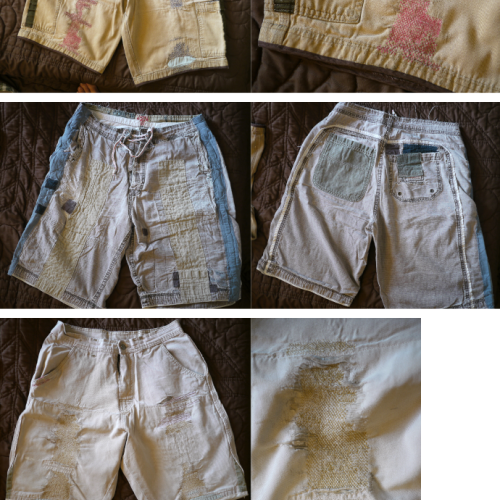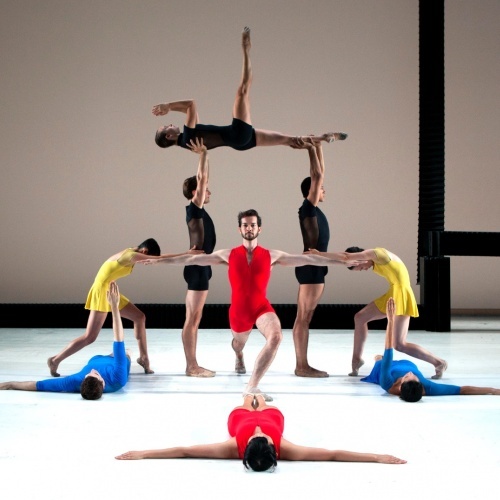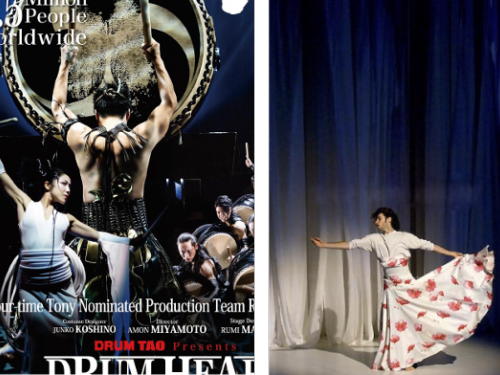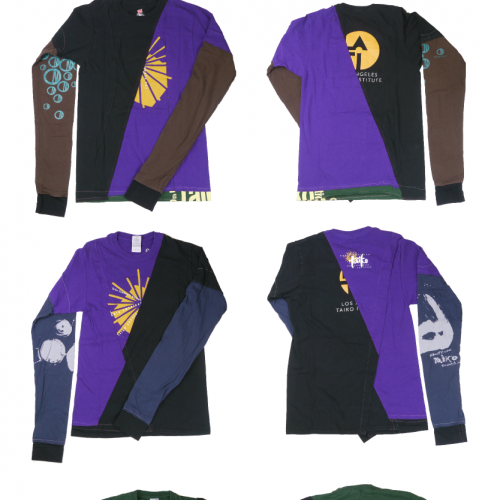The current taiko costume teeters between traditional and contemporary. I believe it's time to push it over the edge.
I started to care about costumes in the mid-2000's at the convergence of two factors: increasing confidence in making my own clothes and increasing discomfort with On Ensemble's costume. My successes in making everyday clothing that was comfortable and practical for taiko felt increasingly at odds with a costume that felt foreign. My discomfort came to a head in 2013, during a performance at the National Theater of Japan. It was one of the most important performances of my career because it was my chance to bring the naname style I'd been developing back to its roots. Unfortunately, my playing was sub-par. I was nervous and made mistakes. My obi came undone and my mic pack slipped down into my pants. I came away feeling like an amateur and that I didn't represent our music well. I vowed to make some changes, including changes to what I wear.
This essay explains those changes. I begin at the limitations I sense in our current taiko costumes and end with my own attempts to develop a costume that represents me. In the process I hope to reveal the exciting possibilities that await curious experimentation and to convince others to join me in costume exploration.
Limitations
I see five key problems that limit the potential of our taiko costumes: Japanese look over Japanese meaning, costume as uniform, color as identity, ancient romanticism, and gendered costumes.
Limitation 1) Japanese look over Japanese meaning
The happi coat has become the default taiko costume. Popularized by influential groups Ondekoza and Kodo, the happi references the Japanese festival. Commendably, many North American groups make their own happi --- the creative designs of collegiate groups and San Jose Taiko's original style come to mind. A clear symbol of Japan, the happi comforts both performer and audience. It borrows legitimacy from Japan, from Kodo, and from the audience's default position of respect for other cultures. Despite these pluses, I think we're limited by this default.
When the seminal taiko group, Ondekoza (later Kodo), adopted the happi as its costume in the 1970's, it was a deep artistic statement. Seeking to escape the ills of modernity --- the suit-and-tie salary-man lifestyle, atomic weapons, over-consumption --- Ondekoza's rebellious artists moved to remote Sado Island, once the site for Japan's exiles. Fueled by a powerful work ethic, these members cooked, cleaned, and tended crops while maintaining a demanding training regimen. For a costume, the young group tapped industrial designer and Japanese craft specialist, Yoshio Okioka. Okioka chose the happi as a symbol of the every-man. He used indigo dye, the color associated with the working class in the Edo period, and a triangular pattern called "uroko-moyo" to reference the island's existing demon drumming costume and the waves of the surrounding seas.

Okioka's choices were defiantly proletariat and local. He did not align the group with nobility by referencing the kimono, or place the group within Japan's modern upper class by using western attire. Nor did he mask the players in foreign fashion. Ondekoza's use of the happi was an act of contrarian self-determinism.
Compare this to my use of happi as a Stanford Taiko member. I was proud to wear it --- representing my acceptance in the group --- but instead of the artful statement of defiance made by Ondekoza, my use of the happi was "fitting a mold". I was following expectations. To our credit, we designed and sewed a set of four happi designs ourselves but I didn't look below that level, to ask whether some other item might better represent my lifestyle and my take on taiko. This image of me in a happi now feels quaint and innocent, like photos of me dressed up for church.
I should pause to recognize that my experiences are obviously not relevant to everyone. A different Stanford Taiko member (Japanese American, or female, perhaps) might have had an altogether different experience wearing happi.
With that caveat aside, however, it feels to me that exciting possibilities for our artform abound at the deeper levels of costume design. If Ondekoza used the color indigo to embrace Japan's past underclass, perhaps an American taiko group could utilize white, American slaves' color of choice for dress clothes because it could be bleached. That's deep. If Kabuki performers in Japan represent their guild with a mon crest on the chest and back, American players could put their symbol on the side or hip, referencing the cattle brand and cowboy culture. Rather than borrowing the Japanese image directly, the underlying meaning of these costumes can provide inspiration that we translate into original costumes. In the same way many of our taiko groups have transitioned from playing others' pieces to playing original music, we're poised to begin the search for our own defiantly local style.
Limitation 2) Costume as uniform
The uniform is deeply entrenched in American and Japanese societies, and in the taiko costume. I think we should end this tradition.
A warning. I have been kicked out of two taiko groups (On Ensemble and UnitOne) for not wanting to wear the uniform. My opinions on this topic have been sharpened through trauma so the following section is a bit more blunt. Also, it may be dangerous to follow my advice.
I hate uniforms.
I understand wanting to look like a team, and I appreciate the ease of having everyone wear the same thing, but the uniform seems to me to be the exact wrong image for North-American taiko. It goes against our cultural and musical ideals and limits our potential.
Uniforms encourage the audience to make simplistic cultural interpretations. The visual unity suggests conformity and "Japan as monoculture". Uniforms encourage superficial comparisons of players' race and body types. The strained obi of the bigger player, the too-short leggings of the tall player, and the baggy happi of the older player mark these members as outliers.
If our music relies on interlocking patterns, variety in instruments, and a range of playing styles, why choose the visual image of uniformity? If our roots are the second and third-generation Japanese Americans' brave efforts to broaden the definition of "American", why should we look the same? North-American taiko celebrates diversity. What if our costumes were attuned to players' differing roles within the group, their diverse images of self, and their individual relationships to Japan? This frees the Japanese American player to wear a happi with her family crest and the words, "I don't know the meaning", in English on the lapel -- a poke at our assumptions of cultural heritage. The group's Korean-American player can wear a happi with Japanese verbal commands "stop", "wait", "work", and a caution-tape obi -- a reference to her Korean parents' forced adoption of the Japanese language and a testament to a generation's ability to heal. The African-American player can wear a pink happi labeled "Cream Soda 50!", an homage to the legendary Harajuku brand, a cathartic inversion of the outsider status she faces with black skin when actually in Harajuku. These costumes are individualized but complementary, inviting deeper discussion about Japan, taiko, and our place in the artform.
Creating meaningful, artful costumes for all players requires that individuals are free to explore, experiment, and ultimately choose what they wear. The uniform requirement should be lifted.
Limitation 3) Color as identity
The use of color to distinguish individuals is another common design choice that can be retired. It is the "Power Rangers" approach and it prioritizes the most superficial variable of costuming. Color is used in costuming the way color is used in candy flavors.
An example from otherwise world-class art...
In May of 2014, the Jessica Lang Dance company presented Lines Cubed at the Wallis Annenberg Center for the Performing Arts. It was challenging, rich choreography that indicated Lang's deep understanding of movement. The dancers wore tight-fitting shirts and shorts (apparently called "biketards"), suitably pliable for movement and permitting the observation of the body. From this perfectly natural start, however, dancers changed to different color biketards to indicate sectional changes in the piece. At its nine-dancer climax, four groups emerge with black, red, yellow, and blue biketards.
This might not have bothered me before I started studying clothing but now it drives me crazy. Of all the tools of fashion --- fit, drape, material, construction, historical reference --- the single variable chosen to distinguish dancers was color. Color!... the key feature our society struggles to divorce from meaning.
Color is chosen because it is easy. It is the option in the catalog. It is off-the-shelf self-expression. To me, a group of players distinguished by color is the very image of commodification.
Imagine instead if the distinguishing characteristic were fabric. Traditional fibers could reference the music's roots with silk from Hachijo for the Hachijo Daiko soloist, indigo cotton from mainland Japan for the naname players, and broadcloth from the eastern US for the debut of the new composition.
We can unchain costumes from the burden of obviousness and push color to its proper place: low on the value hierarchy. We can reward the audience for close observation and curiosity. Why was I "blue" in On Ensemble? I could not have answered.
Limitation 4) Ancient romanticism
By the look of it, taiko performance has existed for centuries. We wear costumes that reference the Edo period, both worker-ware and formal. Hakama and kimono suggest the noh and kabuki theaters and exacerbate the misunderstanding of taiko as ancient art.
Because taiko was started in the 1950's by a jazz drummer, why not look to Japan's contemporary fashion designers for inspiration? Rei Kawakubo and Yohji Yamamoto are monumental designers with diverse portfolios from which to draw inspiration.
I met a group of young women, perhaps 13--14 years old, on the train in Tokyo, wearing tattered clothes stained to look bloody. They were likely coming from Yoyogi Park, at that time a nexus for wild fashion exploration. One of them explained to me, "Blood is the same in everybody... but when you see it, you're scared." Imagine the taiko costume she would design! Instead of working within the traditional Japanese wardrobe, imagine if we followed contemporary Japan's lead in making bold, original statements.
Limitation 5) Gendered costumes
I believe we should also feel free to break from traditionally gendered costumes, both to broaden our design palette and to hasten the cultural transition from gender duality to gender spectrum. If kimono sleeves artfully accentuate Chieko Kojima's graceful drumming and the harakake showcases Kodo's men's muscles, these accents would be all the more inspiring playing against gender stereotypes. Allowing individuals freedom to express their gender identity is critical in the development of authentic, inspired costumes.
Once we make it acceptable for our community to wear contemporary, original, unique costumes, we open the door to vibrant exploration and the potential for great art. It's no minor thing to teach ourselves how to design and make costumes. The process will be long and fraught with setbacks. But if my own experience is any guide, it will be rewarding work.
Personal approach
Untethered to tradition, where should we begin? How do we design an original costume?
We start with what we love. What item in the closet most excites you? What fits perfectly? What do you wear to taiko practice? These clothes contain the shape, the look, and the construction inspiration we need.
For me, it began with a pair of tattered shorts and ill-fitting shirts.

I wore a particular pair of shorts for 12 years. It was my go-to pair, with a perfect fit and useful pockets. I patched and repaired the knees, the seat, and the zipper repeatedly, but at some point the fabric was so frail that repair became untenable. I knew they were finished but I recoiled from the thought of throwing them away. Then it hit me...
The regenerative power of the "pattern".
I disassembled the shorts at the seams and used the pieces to transfer the shapes to pre-shrunk fabric. With some help from a friend (Hiro), we mimicked the original construction and sewed the parts together. It was miraculous. The same, perfect fit, but with brand-new fabric. In the 14 years since, we've made an additional dozen pairs and they continue to improve. Thanks to the pattern, the shorts are immortal!
My shirts began similarly. Though I owned 30 or more taiko t-shirts at any one time, I found myself wearing the same few continually. Everything else was too wide or too short but the idea of tailoring them was intimidating... until I discovered the power of the rolling cutter!
By laying multiple shirts on top of each other and using a rolling cutter to cut them simultaneously, I discovered I could lay out pieces that would fit perfectly. I used this technique to experiment with width and length. I could keep the neck from one shirt, and the bottom from another.
The discovery of a simple construction technique gave me the tool I needed to explore. Through light-hearted experimentation, I realized a closely tailored chest meant the shirt wouldn't slide up when I swing my arms playing naname. I realized a longer shirt with sleeves protects me from the sun when cycling to practice. Eventually we converted the best-fitting, most useful shirt into a pattern of its own and now my ideal shirts are immortal too.
I love everything in my closet. This joy was built from the clothes I had and with the simplest of techniques.
Taiko friends around me are conducting their own costume experiments and I'm hopeful they too will find what they love. I'm emboldened by an increasing sense of freedom circulating in our community.
I would love to have you involved in this experimentation too. I'd love the larger taiko community to try new things and to share designs --- the same way we discuss the details of taiko composition and share rhythms. In addition to our music, I dream we'll apply our vibrant creativity to the exciting world of taiko costumes.


